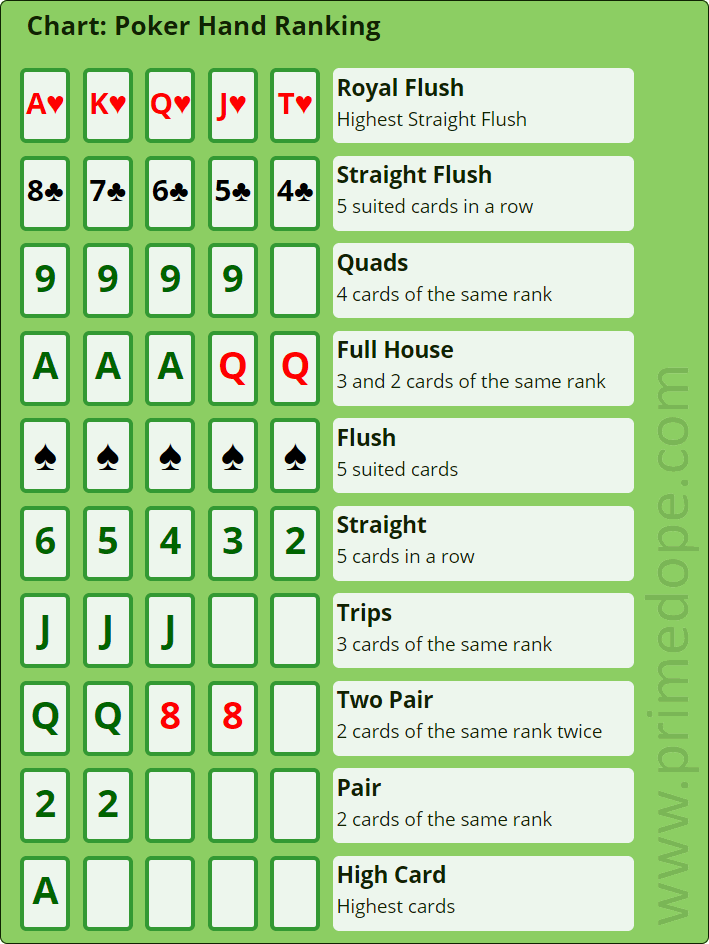- Aces can also be considered low, giving it an added element of deceptive strength and function! That’s right – in the most common forms of poker, an Ace is considered to be both high and low! This fact means that not only will a pair of Aces beat a pair of Kings, but it will also form the low ends of “wheel” straights, like in A-2-3-4-5.
- For example, if your seven cards are Kh 8h 5c 4h 3h 2s Ah, your high hand is Ah Kh 8h 4h 3h, an ace-high flush, while your low hand is 5c 4h 3h 2s Ah, a wheel. Here is a hand that uses the same five cards for low and for high: Ks Qh 8s 7d 6c 5h 4c.
- Ace-High A hand in which the highest ranking card is an ace with no pair or higher valued combination of cards possible. For example, in hold'em if a player's hole cards are and the board comes.
Aces may indeed be used as low in a straight in holdem. A2345 is the lowest possible straight, also sometimes called a 'wheel.' In any other context, aces will be ranked higher than other cards. An ace-high straight, such as A ♣ K ♣ Q ♦ J ♠ 10 ♠, is called a Broadway straight, while a five-high straight, such as 5 ♠ 4 ♦ 3 ♦ 2 ♠ A ♥, is called a baby straight, bicycle or wheel and is the best possible hand in ace-to-five low games (where it is a high card hand, not a straight).
Table Of Contents
What is Omaha Hi-Lo Split-8-or-Better Poker?
If you know how to play pot-limit Omaha (or 'Omaha high'), you are well on your way to learning how to play Omaha hi-lo.
As the name suggests, Omaha hi-lo is a 'split-pot' version of Omaha poker in which players compete for both the 'high' and 'low' halves of the pot. Omaha hi-lo is usually played with fixed-limit betting and often turns up in 'mixed game' formats like H.O.R.S.E. (in which Omaha hi-lo is the 'O') or the popular 8-game mix.
You will sometimes see the game referred to simply as 'Omaha 8' or even 'O/8' or more elaborately as 'Omaha hi-lo split-pot-8-or-better.' The name gets styled differently, too, as 'Omaha High-Low,' 'Omaha poker high-low' and so on.
Pot-limit and no-limit versions of Omaha hi-lo are also popular, especially online either as cash games or tournaments.
Poker Ace High Or Low Rise
How to Play Omaha Hi-Lo Split-8-or-Better Poker
The basic rules for Omaha hi-lo are very similar to pot-limit Omaha. See 'How to Play Omaha Poker' for an overview of how to play Omaha poker, which is itself a variation on regular Texas hold'em.
Just like in pot-limit Omaha, players are dealt four cards in Omaha hi-lo and are required to use two of those four cards in combination with three community cards in order to make a five-card poker hand.
As in hold'em or pot-limit Omaha, if a player bets and everyone folds before the showdown, the player wins the pot without having to show a hand. However, if the final bet is called and there is a showdown, hands are examined to see who has the best 'high' hand and who has the best 'low' hand, with each winning one-half of the pot.
Omaha Hi-Lo Split-8-or-Better Rules
In Omaha hi-lo, the 'high' hand is determined exactly the same way as in hold'em or Omaha 'high' games (like PLO), following traditional hand rankings.
The 'low' hand requires a little more explanation, especially if you are new to split-pot games or hi-lo poker.
Poker Ace High Or Low Voltage
First of all, whatever cards you use to make your high hand, that makes no difference when making your low hand. You can use the same two cards, the other two cards, or any combination just as long as you use two cards from your four-card hand plus three of the community cards to build your five-card poker hand.
The rules of Omaha hi-lo is usually played with a 'qualifier' for the low hand, meaning all of the cards making up a low hand have to be ranked eight or lower. That's where the 'split-8-or-better' comes from, a phrase usually added to the name of the game.

A qualifying low hand consists of five unpaired cards ranked eight or lower. For the low hand, the ace is considered a low card (the lowest), while it can also serve as the highest-ranking card in high hands.
Also worth noting — if your lowest five cards make a straight or a flush, that doesn't matter in Omaha hi-lo, you've still got a low hand (if all are ranked eight or lower). In other 'lowball' games like 2-7 no-limit triple draw, flushes and straights hurt you by making your low hand higher, but in Omaha hi-lo that is not the case.
That means a hand consisting of 5-4-3-2-A would be the lowest possible hand — that is to say, the best 'low hand' in Omaha hi-lo. This hand is sometimes called a 'wheel.' The next lowest possible hand is 6-4-3-2-A. The worst low hand that qualifies as a low in Omaha hi-lo would be 8-7-6-5-4.
A good way to figure out which low hand is best is to arrange the hand from highest card to lowest card and then to think of the hand as a five-digit number, with the lowest number being the best (or lowest) hand. Thus 5-4-3-2-A (54321) is better than 6-4-3-2-A (64321), and 6-4-3-2-A is better than 6-5-3-2-A (65321) and so on.
An Example of an Omaha Hi-Lo Split-8-or-Better Poker Hand
In Poker Is Ace High Or Low
Let's say a hand of Omaha hi-lo goes to showdown with the final board reading 6♣3♠K♦Q♦.
You hold A♣K♠7♦4♣, and your opponent has Q♠J♦4♦2♠.
Your best possible high hand is two pair, aces and kings — using the A♣ and K♠ in your hand pairing them with the ace and king on board, with the queen being a kicker.
Your best possible low hand is 7-6-4-3-A — using the 7♦ and 4♣ in your hand along with the three low cards on the board. Note how you can't use the ace in your hand when making your low hand, since you have to use exactly two cards in your hand and three on the board (and there is an ace on the board).
Your opponent, meanwhile, has you beat both for the high and the low!
Your opponent's best possible high hand is a flush — using the two diamonds in his hand (J♦ and 4♦) and the three diamonds on the board.
Ace High Or Low In Poker
Your opponent's best possible low hand is 6-4-3-2-A — using the 4♦ and the 2♠ in his hand along with the three low cards on the board. 64321 is lower than 76431, so your opponent has you beat.
Winning both halves of the pot like this is called a 'scoop' or 'scooping,' which is something you always want to try to do when playing split-pot or hi-lo poker games.
Sometimes in Omaha hi-lo there is no qualifying low hand. This is the case whenever there are less than three unpaired cards ranked eight or lower on the board.
For example, if the board is 9♣K♦A♥4♥J♠, there are only two cards ranked eight or lower on the board (the ace and four), which means it is impossible for anyone to make a low hand. When that happens, whoever has the best high hand scoops the whole pot.
Conclusion
Omaha hi-lo is not difficult to learn, especially if you already know how to play pot-limit Omaha. The strategy can be complicated, though, with a great deal of importance placed on understanding what are strong starting hands (e.g., hands containing an ace with at least one or two low cards, especially a deuce) and not making the mistake of battling for only half of the pot (just the high or low).
Must Have Rooms
Home to the biggest tournaments online, these rooms also have the largest player base, great bonuses, tons of action and the best software. If you don't have accounts here, you are missing out on the best that online poker has to offer.
PartyPokerplatinum
Poker Ace High Or Low Levels
Up to $30 of Free Play
RATING
9.9 ★
Key features
- Excellent mobile poker games
- Lots of free and real-money action
- One of the most trusted brands in online gaming
In traditional poker games, the player with the best traditional hand wins the whole pot. Lowball variations award the pot to the lowest hand, by any of several methods (see Low hand (poker)). High-low split games are those in which the pot is divided between the player with the best traditional hand (called the high hand) and the player with the low hand.[1]
There are two common methods for playing high-low split games, called declaration and cards speak. In a declaration game, each player declares (either verbally or using markers such as chips) whether he wishes to contest for the high hand or the low hand. The lowest hand among those who declared low wins that half of the pot, and the highest hand among those who declared high wins that half (for further details, see declaration). In a cards speak game, all players simply reveal their cards at showdown and the hands are evaluated by all players; high hand wins half of the pot and low hand wins the other half.
Especially when using the ace-to-five low method, it is possible for one player to have both the low hand and the high hand, and therefore win all of the pot (called 'scooping,' 'hogging' the pot, or 'going pig'). In the event more than one player ties for either high or low, the pot can be further split into quarters or smaller fractions. For example, if one player has the high hand on showdown, and two other players tie for the best low hand, the high hand wins half of the pot and each low hand wins only a quarter of the pot.
It is common, especially in cards speak games, to require a certain hand value or better to win the low half of the pot, called a qualifier. For example, in an 'eight or better to qualify low' game, a player with a hand of eight-high or lower is entitled to win the low half of the pot (assuming his hand defeats all other low hands), but a player with a 10-high or 9-high hand cannot win, even if his hand is the lowest. In this case, the high hand wins the entire pot. There is generally no qualifier to win high, although one common variant is any pair/no pair, where a hand of at least a pair is required to win high and any hand with no pair is required to win low.
In high-low split games where each player is dealt more than five cards, each player chooses five of his cards to play as his high hand, and/or five of his cards to play as his low hand. The sets may overlap: for example, in seven-card stud played high-low split, a player dealt 7-7-6-4-4-3-2 can play a high hand of 7-7-4-4-6 (two pair, sevens and fours) and a low hand of 7-6-4-3-2 (seven-high).
Bluffs can be especially powerful in high-low split games, because a player making a successful bluff wins the whole pot rather than having to share it. This fact also makes bluffs less likely to succeed.
See also[edit]

References[edit]
- ^Zee, Ray (1992). High-Low-Split Poker, Seven-Card Stud and Omaha Eight-or-better for Advanced Players. Two Plus Two Pub.; 2nd edition, ISBN9781880685105[page needed]